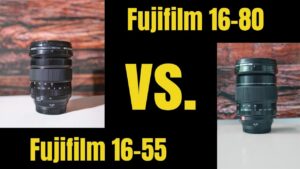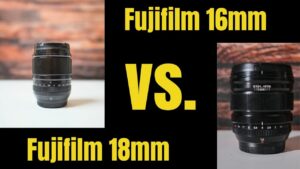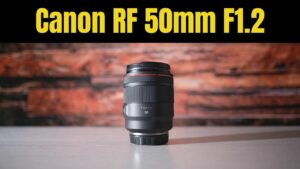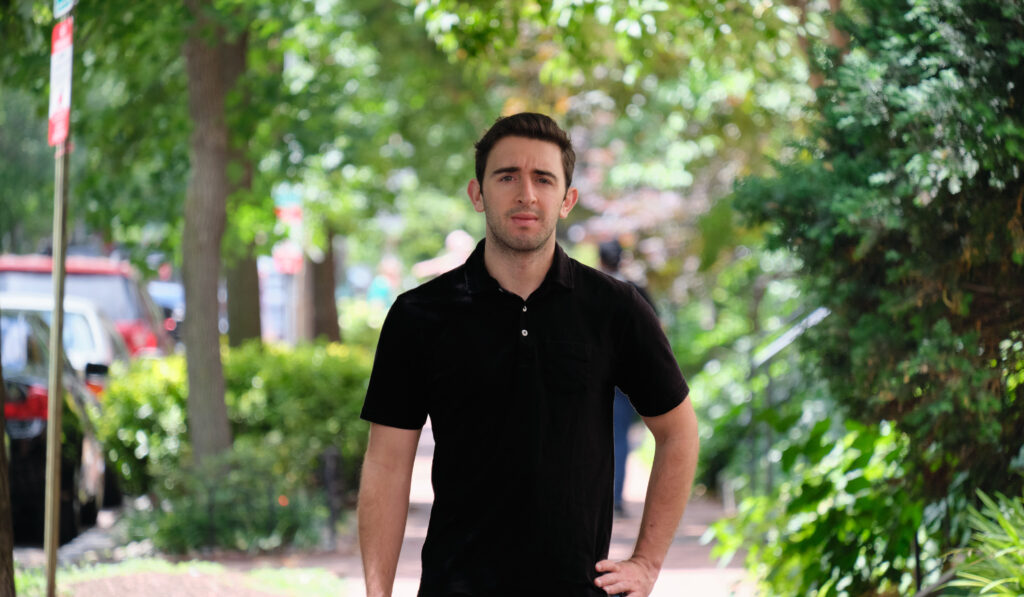Quick Facts about the Fujifilm XF 55-200mm F3.5-4.8 R LM OIS Lens
- Weight: 1.27 lbs/580 Grams
- Weather Sealed: NO
- Filter Size: 62mm
- Angle of View: 29 to 8.1 Degrees
- Focusing Distance: 3.61’/1.1m
- Max Aperture: F3.5-4.8
- Minimum Aperture: F22
- Image Stabilization: Yes
- Mount System: Fuji X
- Price: $699
- Zoom: Extension
Quick Facts about the Fujifilm 70-300mm F4-5.6 R LM OIS WR Lens
- Weight: 1.3 lb/588 Grams
- Weather Sealed: Yes
- Filter Size: 67mm
- Angle of View: 22.9 to 5.4 Degrees
- Focusing Distance: 2.7’/.8 Meters
- Max Aperture: F4-F5.6
- Minimum Aperture: F22
- Image Stabilization: Yes
- Mount System: Fuji X
- Price: $799
- Zoom: Extension
- Accepts Teleconverters*
Table of Contents
Why compare the Fujifilm 55-200 vs the 70-300?
The Fujifilm 70-300 and the older 55-200 have numerous similarities that make this comparison worthwhile. First off, their weight is almost the same!
BUT the most important commonality is the price. Although you can find used copies of the 55-200 for about $400, the MSRP is only about $799 more for the 70-300 while the 55-200 is $699!
For the longest time, the only “budget” telephoto zoom was this 55-200, but now let’s see if almost seven years of technological improvements can be found in this new 70-300! (And if it’s worth the extra $100!)
Who are both of these lenses for?
There is no question. If you are a Fujifilm XF photographer who travels, one of these lenses should be in your camera bag.
After all, the weight and valuable focal length (80-300 FF & 100-450 FF) with a small prime or wide-angle zoom create a powerful combination that rivals some full-frame models.
But in regards to this focal length, let me just provide some types of photography that can be covered by these lenses: Portraiture, Landscape, Wildlife, Birding, Sports.
And as a bonus, the 70-300 can be used as a macro lens!
What other telephoto lenses exist within the Fuji-X lineup?
Zooms
Now, there are some other zoom lenses within the telephoto length. However, lenses such as the 50-140 and 100-400 cost much more (over $1,000) than either of these lenses.
- Fujifilm XF 50-140mm F2.8
- Fujifilm XC 50-230mm F4.5-6.7
- Fujifilm XF 100-400mm F4.5-5.6
Primes
In regards to the 56mm f1.2 and the 90mm f2.0, used copies can be found for the same price of used copies of both of these lenses.
The primes do have better image quality than the 55-200 AND the 70-300, and they are much smaller. If you are looking at purchasing something such as the XT20 or XT30, please keep that in mind.
- Fujifilm XF 56mm F1.2
- Fujifilm XF 80mm F2.8
- Fujifilm XF 90mm F2.0
Build Quality Comparison
Both lenses are built very well, and I have personally carried the 55-200 around the world multiple times.
However, in regards to pure build quality, the 70-300 wins.
Both lenses are made from high-quality plastic. However, the 70-300 just feels a bit… less loose? It’s hard to explain.
With the zoom lock, I am also more confident in sticking this lens in a backpack and traveling over bad terrain.
The zoom lock helps prevents lens creep, which my 55-200 has a tendency to do.
How far is the FOV?
Now, when it comes to examining the FOV’s, I had a very interesting experience.
The 55-200 felt like a standard telephoto zoom. Back in my Canon days, the EF kit lens was the typical 50-230, and I felt right-at-home with this 55-200. (FF 80-300)
But the difference between 55mm and 70mm is significant.
The 55-200 has a Field of View of:
- Angle of View: 29 to 8.1 Degrees
The 70-300 has a Field of View of:
- Angle of View: 22.9 to 5.4 Degrees
The angle of view changes over 6 degrees just between the 55 and 70mm on the shorter-end.
Meanwhile, from 200-300, the FOV changes only less than 3 degrees.
However, the impact of the 55-200’s sharpness fall-off drastically impacts the usable focal length of this lens.
After all, as mentioned in the next section, you really cannot trust this lens past 170mm.
Fujfilm 55-200 vs 70-300 Sharpness Test
Now, when it comes to sharpness, the 55-200 has something that is symbolic of some of the first XF lenses, fall-off in image quality in the corners.
After reviewing the 55-200, lens, here are a few things I noticed regarding the image quality and sharpness test.
- This lens performs its best throughout the entire middle-portion of the zoom range. (From about 70mm-140mm)
- Performance begins to decline at 140mm, and you can start to see the image degradation beginning at 170mm.
- The variable aperture presents a problem, especially when testing the lens for sharpness.
- For some odd reason, the lens performed rather poorly at 50mm.
The pictures below are zoomed in 80% to the extreme top-left third of the frame. The photos below are straight-out-of-camera JPEG with some minor exposure tweaks to maintain similar exposures.
55-200 Brick Wall Test
70-300 Brick Wall Test
*These photos are not cropped. However, they are SOOC JPEG.
Now, here is what I noticed from the Fujifilm’s 70-300 image quality test
- The corners seemed a *bit softer at 70mm @F4.
- The corners at 70mm @F8 and 300mm @F8 look similar in regards to image quality/sharpness
- This lens is very sharp throughout the entire focal range.
Look, there is no question that the 55-200’s sharpness is usable for photography. However, it performs its best where the 70-300’s zoom range really begins. (From about 70-140mm)
That extra reach plus the lack of image quality fall-off place the 70-300 in a different class. If it was up to just this category, the 70-300 would win.
Bokeh Test
In case it wasn’t clear, you should not purchase this lens solely for portraiture. After all, neither of these lenses open up wide than F3.5.
Sure, both lenses can be used for that style of photography. However, you are not relying on the aperture for shallower depth of field and instead relying on the focal length.
My word of advice: Remember distortion goes both ways, on the extreme wide-end and the telephoto.
For an interesting distortion lesson, please see the 10-24mm review.
Otherwise, here are some photos of the bokeh you can achieve from these lenses.
Bokeh Balls Test
The Bokeh Balls on the 70-300 are not round throughout the entire frame at F4. However, it is easy to fix this with a subject standing in the right or left portion of the frame.
Plus, they are round by F8. (As seen in the pictures above.)
However, the 55-200 bokeh balls present a few issues that are almost impossible to correct in post-production.
#1 The Bokeh Balls never rounded out, even at F8.
#2 The Bokeh Balls on the 55-200 suffer from a very apparent onion ring-like effect.
Autofocus Comparison Test
First off, this autofocus comparison could become entirely irrelevant with the recent release of the X-H2s.
However, that camera is $2,500. (And that’s a lot of money.)
So, instead, I will test the autofocus on the latest firmware on a X-T4 with the following settings.
- Any Eye
- Tracking Sensitivity +2
- Autofocus Speed +3
The 55-200 definitely showed some hesitancy to switch between two subjects.
However, in regards to eye autofocus, I felt like the 70-300 was just a bit “stickier.”
It followed me throughout the entire frame, and did a pretty good job noticing me as I jumped into the frame.
I would say that the 70-300 and 50-140 have same, if not similar, autofocus experiences.
Focusing Distance and Macro Performance
For the 55-200, the focusing distance is 3.61 feet (1.1 meter).
For the 70-300, the focusing distance is 2.7 feet (.83 meters).
For the 55-200, the maximum reproduction ratio is .18x.
For the 70-300, the maximum reproduction ratio is .33x.
Now, some people have said that the 70-300 acts as a semi-macro lens because of the reproduction ratio, and it’s close focusing distance. (Certainly a wonderful minimum focusing distance at .83 meters.)
And I have to agree with them.
However, I think this focusing distance also lends itself handy to wildlife photography.
I just completed my test of the 100-400, and I have to say, it was really nice to have the closer focusing distance of the 70-300.
I cannot control the flight path of birds, and with the five foot focusing distance of that lens, I actually failed to get some photos.
Birds would land right next to me, and the 70-300 would be able to get the photo… the 100-400 & 150-600 did not.
OIS Test
According to Fujifilm, the 55-200 provides up to 4.5 stops of image stabilization on non-stabilized bodies such as the X-T3, X-Pro3, and X-T20
However, with the X-T4’s IBIS, you supposedly get up to 5.5 stops.
The 70-300 is rated for 5.5 stops as well. However, I just felt that it was a bit better despite the “so-called” stops of Optical Image Stabilization.
Both of the videos below had no post-stabilization, and I feel like I could use the 70-300 for almost all YouTube videos that require a some telephoto recording.
Starburst/Sunburst
To finish up, both lenses are in the “pass” category when it comes to the starburst/sunburst effect. (Especially as you stop-down to F22.)
By first glance, I lean towards the 70-300’s starburst effect as it is just a bit cleaner around the edges.
However, neither of these lenses are particularly great.
Why should I pick the 55-200 over the 70-300?
There are two reasons to purchase the 55-200 over the 70-300.
#1 Price
The 55-200 has been on the market since 2014. Because of that, there are numerous copies floating around. I was able to purchase my lens for around $400.
#2 The 55-70mm FOV
The FOV for city scenes was just a bit too narrow for me. However, I was able to get some great photographs after I combined about 10 pictures into a panorama in Capture One.
Now, if you pair the 70-300 with a 10-24 and a mid-range prime like the 33mm F1.4, I think you will have a wonderful lens trio.
Why should I pick the 70-300 over the 55-200?
If you notice, in the pros of the 55-200 over the 70-300, I didn’t actually say anything about the performance of the lens.
And there is 1 reason for that.
I think that the 70-300 is optically better in every way over the 55-200. (#hot take)
It is sharper, better optical image stabilization, and a more versatile zoom range.
PLUS, it has little features like the locking feature that make me feel more comfortable about shoving it in my backpack.
If you are looking for the best telephoto zoom for the XF series, the 70-300 is the lens to buy.
My Final Ratings
Fujifilm XF 55-200mm f3.5-4.8 R LM OIS
Reliability: 4/5
This lens struggled when I attempted to record video in continuous tracking.
Functionality: 4/5
When it comes to the 80-300n equivalent, this focal length is desirable and has utility. However, the points are lost for a lack of low-light options.
Style: 4.5/5
These are always bonus points. Build quality is good, but .5 point loss for zoom creep when it’s in my backpack.
Total: 17.5/20 or 82%.
Fujifilm XF 70-300mm f4-5.6 R LM OIS WR
Reliability: 5/5
This lens is very reliable, well-built, and all around an excellent travel lens. I would happily take it on an around-the-world adventure.
Functionality: 4/5
Sometimes, it did feel just a bit too long. But pair it with another lens for night photography and you will be good.
Style: 4.5/5
These are always bonus points. But the 70-300 looks classy.
Total: 18.5/20 or 92.5%

Fujifilm 16-55 vs 16-80mm F4
The Fujifilm 16-80mm F4 and 16-55mm F2.8 are some of the most expensive “normal” zoom lenses that Fuji makes. Is the 16-80 so bad? And is the 16-55 better?

Fujifilm 18mm vs 16mm F1.4
Two of the best performing wide-angle, XF lenses made by Fujifilm, the 18mm and 16mm should be a comparison that most people think about. But why don’t they?

Fujifilm 18mm F1.4 Review
If you have ever wanted to test the new, Fujifilm 18mm F1.4, but you haven’t had the money.. And how does the 18mm F1.4 vs 16mm F1.4 compare?
































